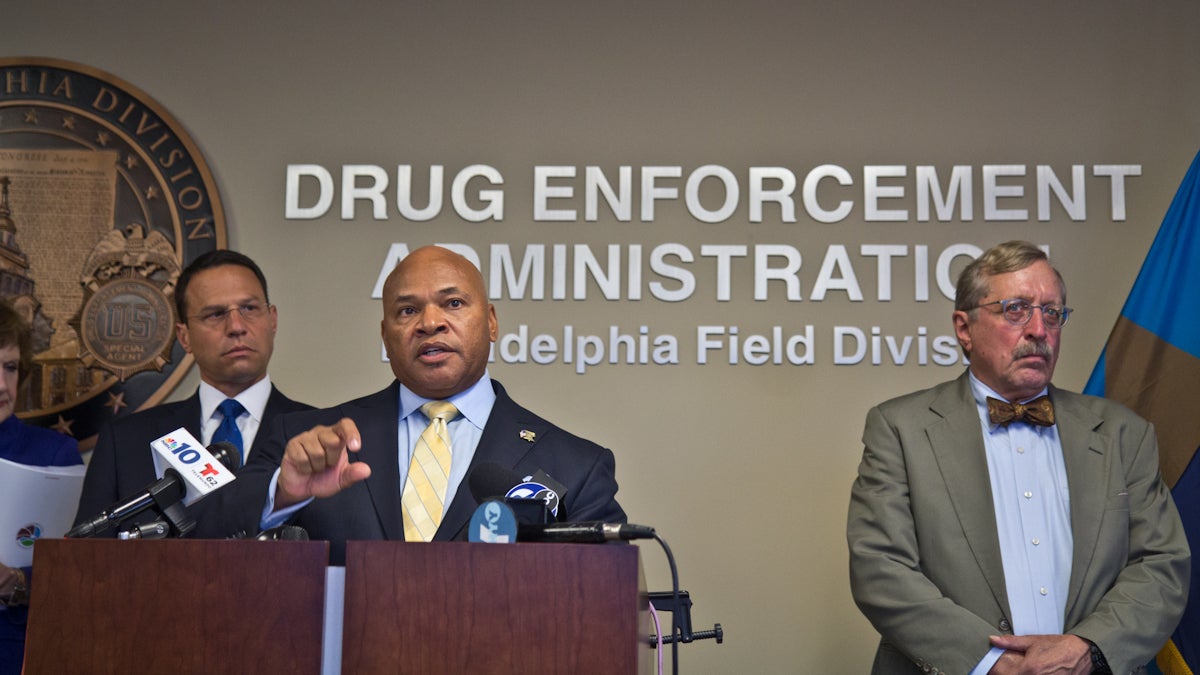13 Pennsylvanians a day died of overdoses in 2016
Listen
Gary Tuggle, head of the DEA Philadelphia Field Division, speaks about the analysis of overdose deaths in 2016 on Thursday afternoon. (Kimberly Paynter/WHYY)
In Pennsylvania, the number of people dying from drug-related overdoses rose nearly 40 percent in 2016, according to a new report from the U.S. Drug Enforcement Administration.
The DEA found that last year, 4,642 Pennsylvanians died from overdoses, or about 13 people a day. It’s a 37 percent increase over 2015.
“It’s not a distressing number. It’s a stunning number,” said Jeremiah Daley, who heads up the Philadelphia-Camden High-Intensity Drug Trafficking Area, an agency that helps coordinate anti-drug policing in the region. “And we have to remember that that number represents people, 4,600 and some people and all their families and loved ones that are affected by this.”
In his 37 years in law enforcement, Daley said he’s never seen statistics this dire.
“This is not a new problem for us, but by God this is the worst it has ever been in all of those years and to my knowledge ever,” he said.
While the number of deaths remains high in urban areas, including the Philadelphia and Pittsburgh metros, the DEA found a sharp increase in the number of fatal overdoses in rural counties. In 2016, fatalities rose by 42 percent in rural counties, compared to 34 in urban counties.
!function(e,t,s,i){var n=”InfogramEmbeds”,o=e.getElementsByTagName(“script”),d=o[0],r=/^http:/.test(e.location)?”http:”:”https:”;if(/^/{2}/.test(i)&&(i=r+i),window[n]&&window[n].initialized)window[n].process&&window[n].process();else if(!e.getElementById(s)){var a=e.createElement(“script”);a.async=1,a.id=s,a.src=i,d.parentNode.insertBefore(a,d)}}(document,0,”infogram-async”,”//e.infogram.com/js/dist/embed-loader-min.js”);2016 Drug-related overdose death demographicsInfogram
The data, supplied by county coroners across Pennsylvania, show the synthetic opioid fentanyl is quickly outpacing heroin as the culprit. The trend is continuing in 2017, said Chief Karl Williams of the Allegheny County medical examiner’s office.
Fifty-two percent of last year’s overdose deaths involved fentanyl, a drug that is cheaper and more potent than heroin, compared to 26 percent the year before.
At the time, drug suppliers were often mixing it with heroin.
“Now folks, drug dealers are just selling fentanyl and the users know they’re getting fentanyl,” said DEA special agent Gary Tuggle. “That’s very dangerous.”
!function(e,t,s,i){var n=”InfogramEmbeds”,o=e.getElementsByTagName(“script”),d=o[0],r=/^http:/.test(e.location)?”http:”:”https:”;if(/^/{2}/.test(i)&&(i=r+i),window[n]&&window[n].initialized)window[n].process&&window[n].process();else if(!e.getElementById(s)){var a=e.createElement(“script”);a.async=1,a.id=s,a.src=i,d.parentNode.insertBefore(a,d)}}(document,0,”infogram-async”,”//e.infogram.com/js/dist/embed-loader-min.js”);2016 Drug-related overdose deaths by quarterInfogram
According to Tuggle, the drug is mainly coming from China and Mexico. The DEA is investigating dealers and drug rings that are selling it on the hidden, encrypted corners of the internet known as the “dark web.”
Law enforcement officials said going after the sources of the drugs is one part of the approach. They also plan to use this new DEA data to work with public health agencies, for example, on ways to get more of the overdose-reversing medication nalaxone into the hands of first responders. It will also help Pennsylvania figure out the best ways to spend a $26.5 million federal grant it received in April to help combat the opioid crisis, said Jennifer Smith, acting secretary of the state Department of Drug and Alcohol Programs.
Armed with this information, the goal is to lower the overdose death rate this year.
“We have a better sense of what’s happening on the ground,” said Pa. Attorney General Josh Shapiro. “We can target specific things. We can determine whether resources in one community should go into diversion, another community should go into particularly looking at fentanyl.
“This report helps us to our job.”
WHYY is your source for fact-based, in-depth journalism and information. As a nonprofit organization, we rely on financial support from readers like you. Please give today.

